How I used Chat GPT to save time researching customers
A practical application of using Chat GPT to spend less time synthesizing insights from customer research
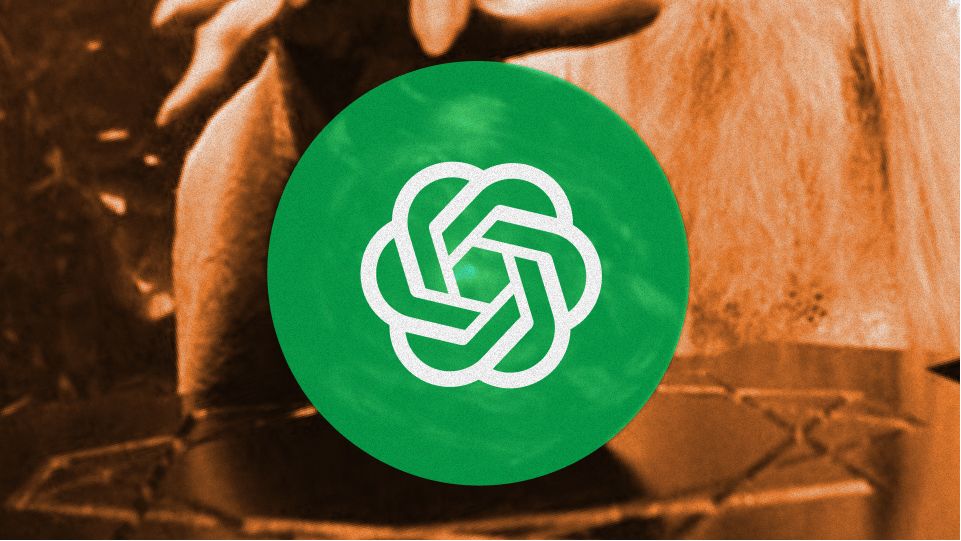
In early 2022, I offered to help a new home construction business to position themselves better in the Sri Lankan market.
Construction is highly competitive industry here. Most business that offered a similar service touts the same messaging such as: "We do NOT sell just homes; we sell Responsibility! Don't Risk It".
Instead of speaking to their customers' needs, they only talk about themselves and offer empty, meaningless platitudes. So, it's easy to say that they're completely out of touch with their customers' motivations. This lack of understanding creates a huge opportunity for a company that knows how to connect with its customers on a deeper level.
As I saw it, we had an opportunity to stand out from them by truly understanding the jobs that its customers were hiring construction companies to do. By using the principles of Jobs-to-be-Done (JTBD) theory, I was able to gain valuable insights into their customers' needs and motivations, that could be used to develop a differentiated messaging and customer service experience.
Recently, I played around with my findings from this research with Chat GPT (a large language model or LLM developed by OpenAI) and wondered if I could achieve a similar or better result by spending less time.
As I unfolded my process with Chat GPT, my emotions ranged from feeling a bit indifferent to being thoroughly surprised and amazed by the output.
By the end of this article, you'll be able to understand its potential benefits and limitations, the exact prompts that I used and a step by step guide at the end so you can apply it yourself with my data or your own.
My current research methodology
The process I used to research the construction domain with JTBD was straightforward:
- I interviewed 9 people who'd recently made the journey to build a house.
- I transcribed those conversations by capturing key quotes with timestamps.
- Then I organized the individual conversations from the interviews into specific themes or categories, and then counted the number of times a quote was mentioned in each theme.
- Finally, I synthesized the findings for presentation.
The most "automated" part of this process was the use of otter.ai to transcribe the conversations. The rest was mostly spent on apple notes tediously organising quotes and synthesizing them.
It could take 2-3 days worth of effort to get to actionable learnings without missing out on anything. As much as I love talking to customers, this was a painful but important part of the process.
Let's find out what can be achieved with Chat GPT.
Organizing quotes into patterns
JTBD style interviews are never linear, the conversations tend to jump back and forth in the buyers timeline so I have to take a bottom-up approach.
Chat GPT claims that it's able to "quickly scan a large number of quotes and identify common patterns." Below is an example output of tasking it to theme the customer quotes that got people started on the journey to build a house.

I'd found that if your input prompt is too broad your output often suffers. It can't decide which level of abstraction to theme it in so you have to be specific.
One benefit of using Chat GPT for organising themes is that you can ask it to refine its output by providing additional input. It's like having a helpful colleague who can iterate on your feedback almost instantly. In my example, I had to ask it for "crisp and actionable" themes, and it was able to generate the above result.
One potential downside of using Chat GPT in this way is that if you input the same prompt and quotes multiple times, it may categorize them differently each time. For example, a quote filed under "personal satisfaction" might be grouped under "desire for ownership" on another occasion. This lack of consistency can make it difficult to use effectively in a team setting.
Synthesizing information
Synthesizing information is both an art and a science. Quotes from an interview do not include the context or the underlying emotions of what was said, which can lead to different researchers interpreting the same quote in different ways.
So, how does Chat GPT handle this?
Synthesizing job stories
In the research I conducted, I used to synthesize the quotes into job stories and then write a summary to assist with presenting the findings.
I personally struggle with this step as it requires careful thought and phrasing in the right manner to communicate the situation and progress customers are seeking.
To get a desirable output with Chat GPT, I had to do some prompt chaining. When you ask it to generate the job stories using individual quotes, it tries to do it for each user when you need it to create the stories across the group. So, instead, you have to ask it to create the high level themes first.
[Paste the quotes]
And after the results are shown...
Input prompt 2: Now could you write them in the job stories format starting with When I... (my circumstances or situation), I want to... (my motivation for change), So that... (my desired outcomes)
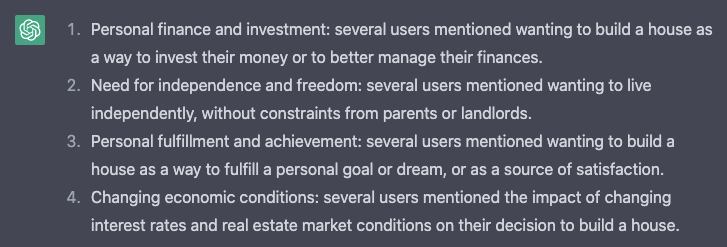
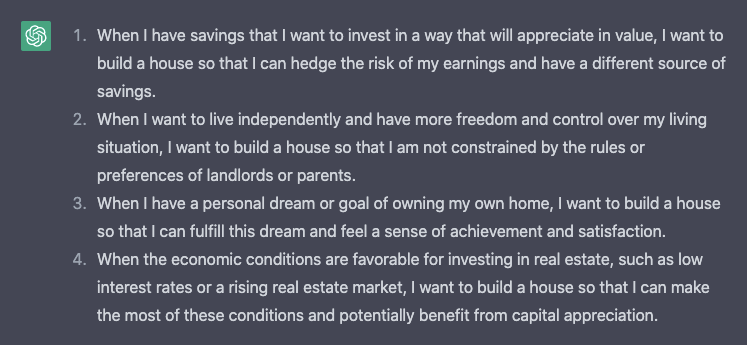
This output was fairly decent. I was hoping it would produce the second job story which was a key focus in the research that I had conducted. That's a win!
However, it does make assumptions which can threaten the integrity of the research. In the second point, it writes about not being constrained by the landlord but there was no mention of it in the quotes or interviews as an outcome that they wanted to achieve. It's a plausible outcome in real life but it didn't show up in the research data.
Furthemore, some of the stories don't frame the situation customers are in properly. For example, "When I have savings that I want to invest in a way that will appreciate in value" sounds more like a motivation than a situation. In my research, I framed this as "When my earnings is depreciating in a savings/fixed deposit account" which is a situation that you can design for.
Synthesizing marketing & service related challenges
The final step in my research process involves analyzing all the data and identifying challenges that my clients would have to address at the top and middle of the customer journey. This is the point at which customers are discovering the business and deciding whether to engage with it.
I tasked it to take the customer quotes and create some problem statements in the HMW (how might we) format. HMW's are a design thinking tool to reframe problems as opportunities. It's best used right before brainstorming for ideas.
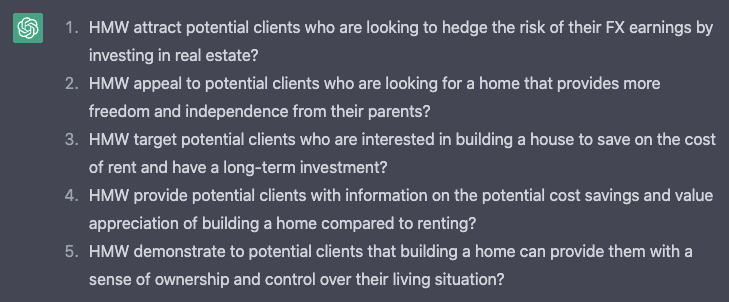
Each of those challenges broadly targets different customer motivations with some healthy overlap. My clients hired me to identify these challenges. I got them in a matter of seconds as opposed to multiple hours worth of work. So now we can go from interviews to insights very quickly.
Let's say that we solved some of those challenges and attracted some leads. What sort of challenges would we have to address to convert them into customers?
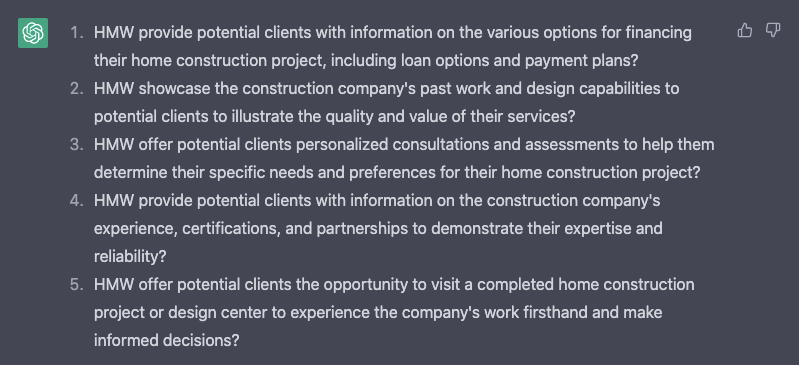
By this point, I was actually shaken by the output. Mainly because I didn't feed it any quotes around what service attributes customers liked about the company that they choose to go with. It's generating these based only on the customers struggling moments.
Additionally, the problem statements are neither too narrow or broad. They're at just the right level to get ideas flowing.
Despite some limitations in its ability to organize data properly, it was able to generate relevant challenges for prioritization and ideation. Hallelujah!
Finally, I asked it to develop some service related challenges that we'd have to solve for, in order to provide a great customer experience.
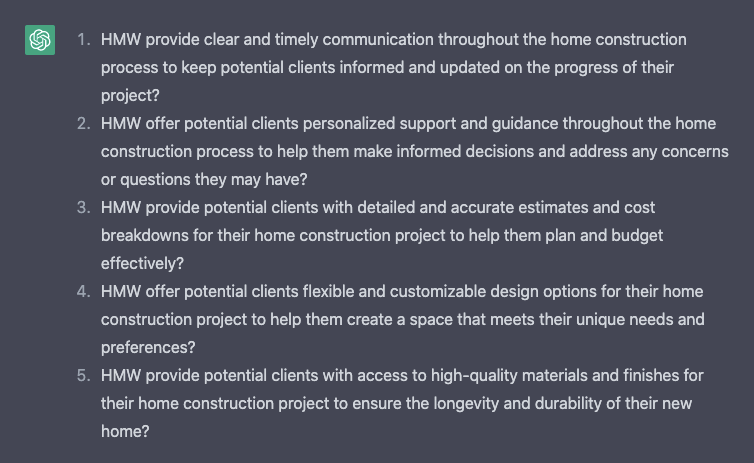
Taking it a step further
From conducting the research interviews, it was clear to me that the segment of customers who had the job of wanting "a space of their own to live with their partner and avoid conflicts with parents" was a viable target segment to go after first.
In Sri Lanka, it's normal for couples to move in with parents after marriage. But as couples mature through time, the need for having their own space, independence and freedom to do things their own way increases. This causes them to switch to a new way of making progress. In our case, this meant building a house.
I never got to this stage with my clients but it made me wonder about what sort of low cost marketing strategy could it suggest that's specific to this segment of customers.
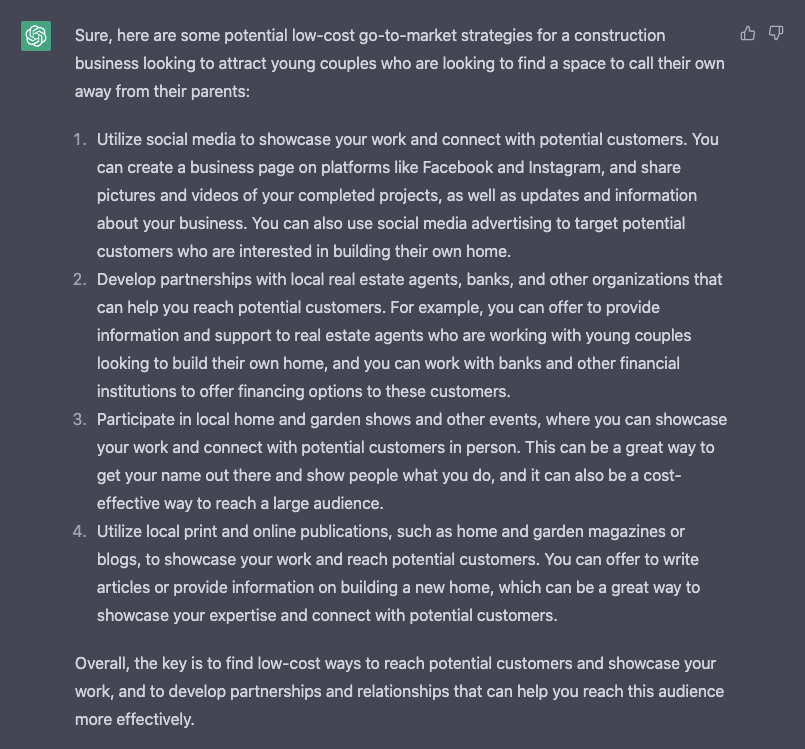
These are great! I could go even deeper by asking it questions around each suggestion.
A step by step guide to replicate my results
Either use these customer quotes (the dataset used in the examples above), conduct your own JTBD interviews or look at your own interview transcriptions for quotes specifically around what caused them to switch to your product/service or a competitors if you're doing analysis.
Depending on the questions you want answered, select a relevant prompt below. It's best to ask it to group quotes into themes before asking anything from point 2 and onwards.
- To group the data into themes: Group these customer quotes into crisp, actionable themes. Include the number of times a quote appears for each theme, who said the quote, and a snippet of the quote relating to the theme. Do it in the table format.
- To generate job stories, first ask it to: Group these customer quotes into themes for [reason for choosing your product]. And then ask it to: Now could you write them in the job stories format starting with When I...?
- To generate problem statements for discovery: Generate 5 problem statements in the HMW format so that we can be discovered by these types of customers.
- To generate problem statements for conversion: Generate 5 problem statements in the HMW format so that we can convert these prospects into customers.
- To build a marketing strategy: Generate a marketing strategy to target [audience name] who are looking to [specific outcome they're looking for].
- To learn more about your customers: Ask it to generate functional, social and emotional motivations from the quotes. The output from these help build more empathy around what they're trying to get done.
- To dive deeper: honestly, the possibilities are endless.
My final thoughts
When I started exploring Chat GPT's potential application for streamlining research, I didn't expect a rollercoaster of emotions. It's clear that it's a powerful tool for synthesizing challenges and ideas when it's grounded by customer quotes. Although, it could improve its ability to organise the data, the time savings is clear.
As for the future, I imagine the ideal "AI driven" research tool being somewhat like an oracle. You give it raw customer data (quantitative quotes and qualitative metrics), and anyone in your team can query it on what their customers struggle with and gain answers on how to alleviate those frustrations. There won't be a need to code findings since the AI can theme it for you.
Since it's still in the research preview stage, it isn't reliable for heavy use. I encourage that you use it as a sounding board for discussing and ideating your research at the moment. Eventually, they'll make it better for all of us to use.
Special thanks to Josh Pitzalis & Mayun Kaluthantri for reading the drafts.